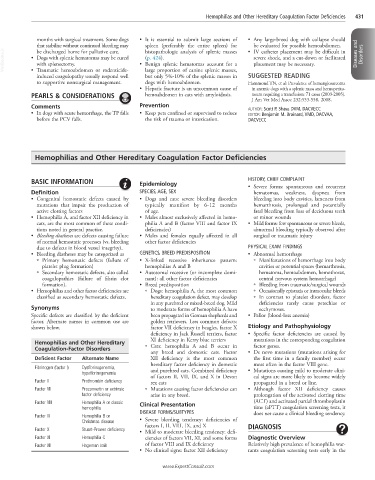Page 886 - Cote clinical veterinary advisor dogs and cats 4th
P. 886
Hemophilias and Other Hereditary Coagulation Factor Deficiencies 431
months with surgical treatment. Some dogs • It is essential to submit large sections of • Any large-breed dog with collapse should
be evaluated for possible hemoabdomen.
that stabilize without continued bleeding may spleen (preferably the entire spleen) for • IV catheter placement may be difficult in
VetBooks.ir • Dogs with splenic hematomas may be cured • Benign splenic hematomas account for a severe shock, and a cut-down or facilitated Diseases and Disorders
histopathologic analysis of splenic masses
be discharged home for palliative care.
(p. 424).
with splenectomy.
placement may be necessary.
• Traumatic hemoabdomen or rodenticide-
but only 5%-10% of the splenic masses in
induced coagulopathy usually respond well large proportion of canine splenic masses, SUGGESTED READING
to supportive nonsurgical management. dogs with hemoabdomen. Hammond TN, et al: Prevalence of hemangiosarcoma
• Hepatic fracture is an uncommon cause of in anemic dogs with a splenic mass and hemoperito-
PEARLS & CONSIDERATIONS hemoabdomen in cats with amyloidosis. neum requiring a transfusion: 71 cases (2003-2005).
J Am Vet Med Assoc 232:553-558, 2008.
Comments Prevention AUTHOR: Scott P. Shaw, DVM, DACVECC
• In dogs with acute hemorrhage, the TP falls • Keep pets confined or supervised to reduce EDITOR: Benjamin M. Brainard, VMD, DACVAA,
before the PCV falls. the risk of trauma or intoxication. DACVECC
Hemophilias and Other Hereditary Coagulation Factor Deficiencies
BASIC INFORMATION Epidemiology HISTORY, CHIEF COMPLAINT
• Severe forms: spontaneous and recurrent
Definition SPECIES, AGE, SEX hematomas, weakness, dyspnea from
• Congenital hemostatic defects caused by • Dogs and cats: severe bleeding disorders bleeding into body cavities, lameness from
mutations that impair the production of typically manifest by 6-12 months hemarthrosis, prolonged and potentially
active clotting factors of age. fatal bleeding from loss of deciduous teeth
• Hemophilia A, and factor XII deficiency in • Males almost exclusively affected in hemo- or minor wounds
cats, are the most common of these condi- philia A and B (factor VIII and factor IX • Mild forms: few spontaneous or severe bleeds,
tions noted in general practice. deficiencies) abnormal bleeding typically observed after
• Bleeding diatheses are defects causing failure • Males and females equally affected in all surgical or traumatic injury
of normal hemostatic processes (vs. bleeding other factor deficiencies
due to defects in blood vessel integrity). PHYSICAL EXAM FINDINGS
• Bleeding diatheses may be categorized as GENETICS, BREED PREDISPOSITION • Abnormal hemorrhage
○ Primary hemostatic defects (failure of • X-linked recessive inheritance pattern: ○ Manifestations of hemorrhage into body
platelet plug formation) hemophilias A and B cavities or potential spaces (hemarthrosis,
○ Secondary hemostatic defects, also called • Autosomal recessive (or incomplete domi- hematoma, hemoabdomen, hemothorax,
coagulopathies (failure of fibrin clot nant): all other factor deficiencies central nervous system hemorrhage)
formation). • Breed predisposition ○ Bleeding from traumatic/surgical wounds
• Hemophilias and other factor deficiencies are ○ Dogs: hemophilia A, the most common ○ Occasionally epistaxis or intraocular bleeds
classified as secondary hemostatic defects. hereditary coagulation defect, may develop ○ In contrast to platelet disorders, factor
in any purebred or mixed-breed dog. Mild deficiencies rarely cause petechiae or
Synonyms to moderate forms of hemophilia A have ecchymoses.
Specific defects are classified by the deficient been propagated in German shepherds and • Pallor (blood-loss anemia)
factor. Alternate names in common use are golden retrievers. Less common defects:
shown below. factor VII deficiency in beagles, factor X Etiology and Pathophysiology
deficiency in Jack Russell terriers, factor • Specific factor deficiencies are caused by
XI deficiency in Kerry blue terriers
Hemophilias and Other Hereditary ○ Cats: hemophilia A and B occur in mutations in the corresponding coagulation
Coagulation-Factor Disorders factor genes.
any breed and domestic cats. Factor • De novo mutations (mutations arising for
Deficient Factor Alternate Name XII deficiency is the most common the first time in a family member) occur
hereditary factor deficiency in domestic most often in the factor VIII gene.
Fibrinogen (factor I) Dysfibrinogenemia, and purebred cats. Combined deficiency • Mutations causing mild to moderate clini-
hypofibrinogenemia
of factors II, VII, IX, and X in Devon cal signs are more likely to become widely
Factor II Prothrombin deficiency rex cats propagated in a breed or line.
Factor VII Proconvertin or extrinsic ○ Mutations causing factor deficiencies can • Although factor XII deficiency causes
factor deficiency arise in any breed. prolongation of the activated clotting time
Factor VIII Hemophilia A or classic Clinical Presentation (ACT) and activated partial thromboplastin
hemophilia time (aPTT) coagulation screening tests, it
DISEASE FORMS/SUBTYPES does not cause a clinical bleeding tendency.
Factor IX Hemophilia B or
Christmas disease • Severe bleeding tendency: deficiencies of
factors I, II, VIII, IX, and X DIAGNOSIS
Factor X Stuart-Prower deficiency • Mild to moderate bleeding tendency: defi-
Factor XI Hemophilia C ciencies of factors VII, XI, and some forms Diagnostic Overview
Factor XII Hageman trait of factor VIII and IX deficiency Relatively high prevalence of hemophilia war-
• No clinical signs: factor XII deficiency rants coagulation screening tests early in the
www.ExpertConsult.com

